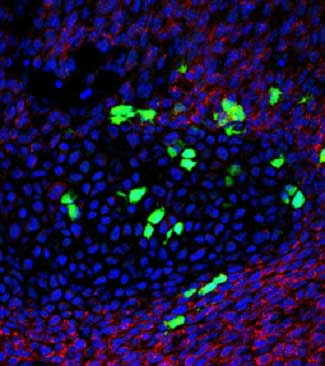| RIKEN Center for Developmental Biology (CDB) 2-2-3 Minatojima minamimachi, Chuo-ku, Kobe 650-0047, Japan |
“It is somewhat surprising that almost nothing has been known about the developmental origin of MSC,” says Nishikawa, “as they are widely used in clinical practice. Now I’m happy to say we have unequivocally determined one of the multiple developmental pathways leading to these stem cells as well as developed a method for enriching MSC progenitors.” Era began by comparing a pair of methods for inducing mesenchymal lineages from embryonic stem (ES) cells, one involving culture on a collagen-coated dish and another in which the ES cells are exposed to pulses of retinoic acid and then incubated under adipocytes-inducing conditions. They found that under both conditions, cells would begin to express PDGFRα, a mesenchymal marker, but that the cells cultured under the second condition (Condition B) were capable of sustained growth and showed ten times the adipogenic activity of Condition A, suggesting that only cell populations cultured using this method contained mesenchymal progenitors. As Condition A is known to favor mesodermal differentiation, the group concluded that MSCs must arise from a non-mesodermal source. They next examined expression of lineage-specific molecular markers in cell lines cultured under Conditions A and B, and found that under Condition A markers for mesoderm and endoderm were expressed, in line with expectations, but that neural markers were detected only in lines cultured under Condition B. using Sox1 as a definitive neural marker, the group used GFP labeling to visualize Sox1+ cells and found that Condition B does indeed support preferential differentiation toward the neural lineage. On maintaining these cells for longer periods, they discovered that a subset of the Sox1+ cells eventually stopped expressing this and other neural genes and began to express PDGFRα, indicating a lineage shift toward mesenchyme. Having dissected the multistep MSC differentiation in vitro, Era sought to confirm it in vivo as well. Taking cells from the embryonic trunk at E9.5, the group sorted them into three subpopulations of Sox1+ PDGFRα-, Sox1- PDGFRα+, and Sox1- PDGFRα- cells, and found that their expression profiles agreed with the conclusions of the in vitro work: Sox1+ PDGFRα- cells corresponded to neuroepithelium, while Sox1- PDGFRα+ cells were mesodermal, not neural, in character. Only the Sox1+ group was capable of sustained growth in culture and of giving rise to multipotent MSC lines. Using a persistent labeling system to trace the developmental origins of mesenchymal cells, they found that these are derived both from trunk neural crest and a second, still unidentified origin that appears to be the major source of PDGFRα+ cells. Importantly, the MSCs within this PDGFRα+ population are distinct from the oligodendrocyte precursor cells that arise from the neural tube, suggesting that mesenchymal stem cells are a unique developmental entity. “As a research group that has long been involved in research using ES cell differentiation culture, we wanted to show that this can be a versatile tool for defining the developmental origins of specific cell lineages,” adds Nishikawa.“We hope that the same methodology can be applied to clarify the developmental origins of other important cell lineages such as pericytes and microglial cells, which remain obscure to this day.” |
|||||
|
|||||
 |
| Copyright (C) CENTER FOR DEVELOPMENTAL BIOLOGY All rights reserved. |
